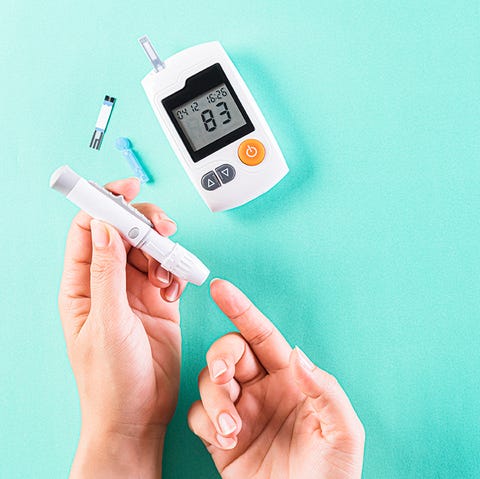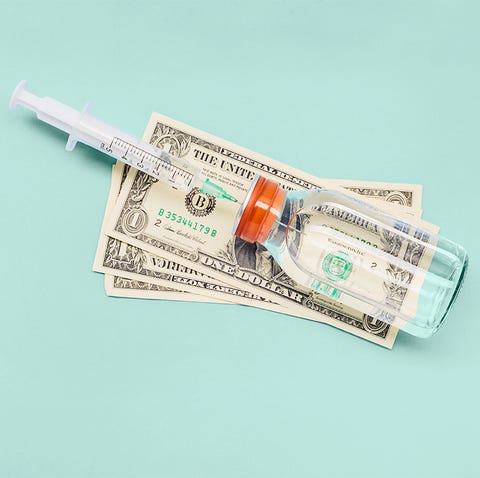From verywellhealth.com
Type 2 diabetes is a progressive disease; chronically elevated blood sugars can worsen diabetes over time and increase the risk of complications. However, lifestyle changes, medications, and diabetes self-management strategies can help to prevent, treat, manage, and slow the progression of the disease.
This article discusses how and why type 2 diabetes worsens and shares tips to help manage diabetes complications.
Insulin Resistance
Insulin is a hormone in the body that regulates blood sugar (glucose). Your body's ability to process and use insulin effectively plays a significant role in developing type 2 diabetes.
Insulin resistance happens when your body's cells do not respond as well to insulin, causing glucose to build up in the blood and raise your blood sugar level. When your body becomes less sensitive to insulin, it tries to produce more, putting you at higher risk for type 2 diabetes.
If you have type 2 diabetes, insulin resistance may worsen over time, especially if you have excess weight in your abdominal area. People who are newly diagnosed with diabetes often try lifestyle changes first (depending on their blood sugar levels at diagnosis). If lifestyle changes are not enough to improve blood sugars, medications to reduce insulin resistance will be prescribed.
Weight loss, healthy eating, and exercise can also combat insulin resistance and should be adopted in addition to taking medications.
Beta Cell Dysfunction
Beta cells are a type of cell in the pancreas that produce and release insulin. After you eat or drink something that raises your blood sugar, beta cells produce insulin to regulate your glucose levels.
Over time, when you have type 2 diabetes, it can become harder for these cells to keep up with your insulin needs. This extra work may cause these cells to stop working as they should or die, sometimes referred to as beta cell dysfunction.
Vascular Cell Complications
As type 2 diabetes progresses, it affects the body in many ways. Below are the most common ways that diabetes affects your health.
Neuropathy
Neuropathy is a sensation of tingling, numbness, or pain, usually in the hands or feet. This occurs due to nerve damage caused by high levels of glucose and fats called triglycerides. High levels of blood glucose can cause damage to small blood vessels that provide nutrients and oxygen to your nerves. If you have type 2 diabetes, neuropathy is more likely to develop as you age and the longer you have the condition. The risk for neuropathy also increases if you have:
- Excess body weight
- High blood pressure
- High cholesterol
- Chronically elevated blood sugar
- Vascular disease
- A smoking habit
About half of people with diabetes (all types of diabetes, not just type 2) report neuropathy as a symptom of diabetes.
Medications, physical therapy, and occupational therapy are some ways to help manage neuropathy. Achieving good glycaemic control, exercising, and not smoking can also improve neuropathy.
Retinopathy
The retina, a light-sensitive tissue in the back of the eyes, has tiny blood vessels. Too much glucose in the body can make those blood vessels swell, leak, or even grow new blood vessels. This is known as diabetic retinopathy
In its early stages, retinopathy may have no symptoms. Vision changes or seeing dark spots or streaks are symptoms in later stages. Retinopathy can lead to vision loss and blindness if untreated, so if you have diabetes, it's vital to get a comprehensive eye exam annually or as often as your eye doctor advises.
The most common causes of diabetic retinopathy include chronically elevated blood sugars, duration of diabetes, and high blood pressure. The risk for retinopathy increases over time with the condition and affects more than half of people with diabetes.
Early detection, screening, and treatment is important for eye health. People with diabetes can potentially prevent or delay retinopathy by keeping their blood sugar, lipid (fat) levels, and blood pressure under control. People with diabetes who are planning to get pregnant should have a dilated eye exam and talk to their doctor about eye health, as the risk is greater in pregnancy.
Kidney Disease
Almost 1 in 3 people with diabetes have kidney disease. In fact, it is the most common cause of kidney disease and a leading cause of kidney failure.
In those with diabetes, high glucose can cause damage to blood vessels in the kidneys. High blood pressure, common among people with diabetes, also damages the kidneys.
Risk factors that increase the chance of kidney disease include:
- Excess weight
- Having diabetes for a long time
- High blood pressure
- Smoking
The risk for kidney disease is also higher among Black, American Indian, or Latino populations.
You should check your kidneys once a year if you have type 2 diabetes. This is done through urine and blood tests.
Coronary Disease
The chance of developing heart disease, including coronary artery disease (the most common type of heart disease), doubles when you have diabetes. This risk increases the longer you have diabetes.
High blood pressure, high cholesterol, and too little physical activity are associated with a higher risk for coronary disease. So are smoking and being overweight.
Having diabetes also raises the chances of heart issues, including heart failure and arrhythmias(heart rhythm problems), such as atrial fibrillation(irregular heart rhythm).
Regular blood pressure, cholesterol, and weight checks can help your healthcare provider determine if you need specific heart tests. Staying physically active and eating a healthy diet are two ways to watch out for your heart health.
Stroke
A stroke is an interruption of blood flow to the brain that can cause brain damage, movement problems, and emotional issues. If not treated quickly enough, it can be fatal.
If you have diabetes, you're twice as likely to have a stroke as those without the condition. Too much glucose in the blood over time can lead to more fatty deposits, or clots, in your blood vessels; these increase the risk for stroke when you have diabetes.
Your risk for stroke is higher if you:
- Have a family history of stroke
- Have high blood pressure
- Smoke
There is also a higher prevalence of stroke in people with diabetes who are Black or over age 55.
By monitoring your blood sugar, blood pressure, and cholesterol regularly with a healthcare provider—and making lifestyle changes to keep your numbers in the good range—you can lower your risk for stroke.
Improving Your Quality of Life When You Have Diabetes
Here are some ways you can improve your quality of life when you have diabetes:
- Educate yourself about diabetes. Meet with a Certified Diabetes Care and Education Specialist (CDCES) for diabetes self-management education and individualized medical nutrition therapy. This is a benefit usually covered by insurance.
- Know your numbers. Knowing your haemoglobin A1C, cholesterol, and blood pressure numbers can help you better control them, reducing the chances of more serious side effects.
- Monitor your blood sugar as often as your health provider advises. Make any changes needed to get your glucose into a healthy range.
- Ask for help if you're having trouble coping. It's OK to feel stressed or upset by a diabetes diagnosis. Talking to a trusted friend, support group, or counsellor may help you find solutions to better manage your diabetes.
End-Stage Diabetes
"End-stage diabetes" is a phrase sometimes used to refer to advanced diabetes complications. This may include kidney failure, heart disease, and vision loss caused by diabetic retinopathy. End-stage diabetes may occur after living with poorly-controlled diabetes for many years.
It's not common to die from diabetes. However, it is more common to have diabetes-related complications, like coronary heart disease or stroke, that could lead to death.
Slowing the Progression
Fortunately, there are steps you can take when you have type 2 diabetes to prevent complications and lower your risk for heart disease, kidney disease, and other health issues.
- Maintain regular checks with your healthcare provider. These checks may include completing and reviewing lab tests and asking any questions you may have.
- Use your diabetes medications as prescribed by your healthcare provider.
- Engage in physical activity. If you're new to exercise, talk to your healthcare provider about the best way to get started.
- Eat a healthy diet. Consume more fruits, vegetables, and other high-fibre foods.
- Aim to get enough sleep. For most adults, that's about eight hours a night.
- Maintain a healthy weight. Even a 5% reduction in your weight from healthy lifestyle changes can help with cholesterol, high blood pressure, and overall health.
Summary
Type 2 diabetes is a progressive disease that can cause damage over time, especially when blood sugars are poorly controlled and chronically elevated. This can lead to damage throughout the body, including the eyes, kidneys, and other areas, and multiple complications. Having type 2 diabetes also increases the risk of heart disease and stroke.
If you have diabetes, you can help lower your chances of diabetes progression by eating a high-fibre diet, getting regular physical activity, and using diabetes medications as prescribed by your healthcare provider.
A Word From Verywell
Having diabetes is not a guarantee that you will have serious health problems. If you keep your blood sugar under control and monitor other health numbers, such as blood pressure and high cholesterol, that can go a long way toward staying healthy. By following recommended appointments with healthcare providers, you can catch potential issues early on and get treated for them.
FREQUENTLY ASKED QUESTIONS
Yes, people with diabetes live longer and have fewer complications with good diabetes management. Lifestyle changes such as healthy eating, weight management, adequate sleep, regular exercise, and stress management make a difference. While it's still possible to have diabetes complications if you're making healthy choices, they usually go a long way toward preventing diabetes from worsening.
With type 2 diabetes, your body becomes resistant to its own insulin. As a result, the body's beta cells produce more insulin to compensate for this resistance. However, beta cells can't keep up with the body's insulin needs. This leads to a type 2 diabetes diagnosis.
Type 2 diabetes is associated with a six-year loss in life expectancy compared to those without the condition. Healthy lifestyle choices can help increase life expectancy when you have type 2 diabetes. Keep in mind that everyone's journey with diabetes is different, and predicting generalised life expectancy is nearly impossible.


:max_bytes(150000):strip_icc():format(webp)/GettyImages-1331143719-71238fda47074dde891ee9e8d25cf7d6.jpg)

:max_bytes(150000):strip_icc():format(webp)/GettyImages-1288968370-4467e5be877243db98e741f1c769cc85.jpg)